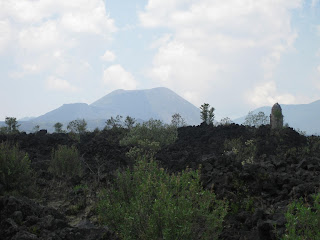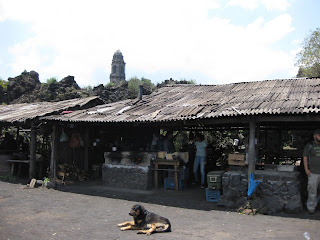It is said that, when
the King of Spain asked Hernán Cortés to describe the Kingdom of New Spain, the
conqueror crumpled up a piece of parchment. Much of Mexico is, indeed crumpled,
by mountains of volcanic origin. The two most famous (and not easy to
pronounce) volcanoes preside over the city of Mexico: Popocatépetl (smoking
mountain) and Ixtaccíhuatl (white woman). Both are hundreds of thousands of
years old.
 |
| Paricutín from a distance |
 |
| The lava field |
The youngest member of
the Mexican volcano family was born in Michoacán. In February 1943 a farmer,
Dionisio Pulido left his village named San Juan Parangarikutirhu to prepare his
field for the approaching planting season. He noticed a crack in the ground
that was emitting smoke and stones. Dionisio rushed back home to alert his
neighbours. Eight months later a cone of ash 365 metres tall loomed over San
Juan and a stream of lava moved slowly but surely down the slope to the now
empty homes.
Jan and I joined an
end-of-conference outing for a group of historical demographers. Their meeting
was entitled Causes of Death in Mexico from the Colonial Period to the 20th
Century. They were clearly in the mood for some more light-hearted
activity. Our mini-bus took us up some 900 metres to the Purhépecha meseta:
large valleys and rolling plains fringed by mountains. In the towns,
traditional wooden buildings (trojes) stand beside anonymous modern
concrete buildings. Farming here does not mean the berries of Zamora, but
livestock (cows, goats, sheep) and avocado trees. Every town seems to have a comedor
comunal (community dining room), set up by the federal government as part
of its Cruzada Nacional Contra el Hambre (National Crusade Against
Hunger). For all their traditional architecture, indigenous traditions and
beautiful landscape, these communities have lagged behind the economic
development of Zamora or the factories further to the north.
 |
| The upper part of the façade of the church |
Signposting in the
meseta is non-existent. We were fortunate that Chantal, our driver, was
familiar with the route. At Angahuan a hand-made sign points to El Volcán.
From here one bounces along a narrow dirt road, manoeuvring round parked
vehicles and oncoming trucks. Eventually, the road leads to the restaurant that
offers views of the volcano’s cone and the lava field and the pine forest of
the sierra. The round trip to the volcano is at least four hours on horseback,
so we limited ourselves to the lava field. The homes of Don Dionisio and his
neighbours lie under a thick layer of black lava, but parts of the church at
which they worshipped remain. The façade is half-submerged in black stone, but
the upper register and the towers (one not yet finished in 1943) stand alone in
the lava.
 |
| St. James The Apostle interior |
 |
| The sotacoro of St. James the Aspostle |
 |
| The huatapera chapel at Nurío |
Behind the church is
the walled enclosure of the huatapera (chapel and community centre,
which in colonial times included a hospital). The plain exterior of the chapel
of the Immaculate Conception belies the 17th-century Baroque
interior and altarpiece, rich in gold and statues of saints. In the early 19th-century
the painter Gregorio Cervantes and carpenter José Characu added a richly
decorated sotacoro depicting the apostles. During our visit, a lady in
traditional dress was giving young girls and a few boys a talk, in Spanish,
about moral behaviour and the importance of avoiding temptations.
 |
| Church of St. Bartholomew, Cocucho |
We moved on to another
purhépecha town, Cocucho, renowned for its ceramics. The potters of Cocucho
mould by hand clay mixed with volcanic sand to form large vessels. They polish
them with wet stones or olotes (the core of a maize cob) before firing
them under piles of wood. Maize dough mixed with water is applied to the hot vessels:
the results are tones of brown, gold or black.
 |
| St. Bartholomew interior |
The church here is
devoted to St Bartholomew. The building is 17th century, but the
interior was much altered in the 18th century. Here the sotacoro
depicts Santiago Matamoros (St James the Moor killer) chopping up a Muslim.
It is most unlikely that an 18th century Mexican artist had much
idea of what a Moor looked like: certainly, the dismembered Moors resemble St
James and the Spanish soldiers carrying firearms. Around this rather disconcerting
scene, angels play European instruments. Fortunately, on the day we visited,
the people of Cocucho had their minds on something more positive than
dismembering Muslims. The main street was blocked by a fiesta: we had some
trouble finding our way out of town, but eventually descended to the searing
heat of Zamora.
 |
| The sotacoro of St. Bartholomew |














No comments:
Post a Comment